Monograph of Coccinia (Cucurbitaceae)
- PMID: 26312043
- PMCID: PMC4547038
- DOI: 10.3897/phytokeys.54.3285
Monograph of Coccinia (Cucurbitaceae)
Abstract
This monograph deals with all 95 names described in the Cucurbitaceae genus Coccinia and recognizes 25 species. Taxonomic novelties are Cocciniaadoensisvar.aurantiaca (C.Jeffrey) Holstein, stat. nov., Cocciniasessilifoliavar.variifolia (A.Meeuse) Holstein, stat. nov., and Cocciniaadoensisvar.jeffreyana Holstein, var. nov. For the 25 species 3157 collections were examined, of which 2024 were georeferenced to produce distribution maps. All species are distributed in sub-Saharan Africa with one species, Cocciniagrandis, extending from Senegal in West Africa east to Indonesia and being naturalized on Pacific Islands, in Australia, the Caribbean, and South America. Coccinia species are dioecious creepers or climbers with simple or bifid tendrils that occupy a range of habitats from arid scrubland, woodlands to lowland rainforest and mist forest. The corolla of Coccinia species is sympetalous, usually pale yellow to orange, and 1 to 4.5 cm long. Pollination is by bees foraging for pollen or nectar. After pollination, the developing ovary often exhibits longitudinal mottling, which usually disappears during maturation. All species produce berries with a pericarp in reddish colors (orange-red through to scarlet red), hence the generic name. The globose to cylindrical fruits contain numerous grayish-beige flat to lenticular seeds. Chromosome numbers are 2n = 20, 24, and 22 + XX/XY. Many Coccinia species are used for food, either as roasted tubers, greens as spinach, or the fruits as vegetables. Medicinal value is established in Cocciniagrandis, of which leaves and sap are used against diabetes.
Keywords: Coccinia; Cucurbitaceae; biogeography; molecular phylogeny; morphology; sex expression; taxonomy; useful plants.
Figures
















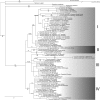


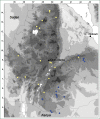

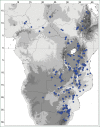
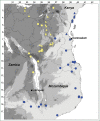




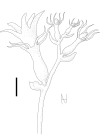
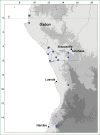
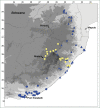


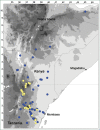


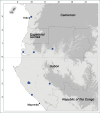





Similar articles
-
A dated phylogeny and collection records reveal repeated biome shifts in the African genus Coccinia (Cucurbitaceae).BMC Evol Biol. 2011 Jan 26;11:28. doi: 10.1186/1471-2148-11-28. BMC Evol Biol. 2011. PMID: 21269492 Free PMC article.
-
Hydroids (Cnidaria, Hydrozoa) from Mauritanian Coral Mounds.Zootaxa. 2020 Nov 16;4878(3):zootaxa.4878.3.2. doi: 10.11646/zootaxa.4878.3.2. Zootaxa. 2020. PMID: 33311142
-
Coccinia intermedia - a new Cucurbitaceae species from West Africa.PhytoKeys. 2011;(7):27-36. doi: 10.3897/phytokeys.7.2032. Epub 2011 Nov 29. PhytoKeys. 2011. PMID: 22287923 Free PMC article.
-
Ivy gourd (Coccinia grandis Voigt, Coccinia cordifolia, Coccinia indica) in human nutrition and traditional applications.World Rev Nutr Diet. 2003;91:60-6. doi: 10.1159/000069929. World Rev Nutr Diet. 2003. PMID: 12747088 Review. No abstract available.
-
Radiation of pollination systems in the Iridaceae of sub-Saharan Africa.Ann Bot. 2006 Mar;97(3):317-44. doi: 10.1093/aob/mcj040. Epub 2005 Dec 23. Ann Bot. 2006. PMID: 16377653 Free PMC article. Review.
Cited by
-
The evolution of huge Y chromosomes in Coccinia grandis and its sister, Coccinia schimperi.Philos Trans R Soc Lond B Biol Sci. 2022 May 9;377(1850):20210294. doi: 10.1098/rstb.2021.0294. Epub 2022 Mar 21. Philos Trans R Soc Lond B Biol Sci. 2022. PMID: 35306898 Free PMC article.
-
UHPLC-HRMS/MS-Based Metabolic Profiling and Quantification of Phytochemicals in Different Parts of Coccinia grandis (L.) Voigt.Food Sci Nutr. 2025 Feb 10;13(2):e70004. doi: 10.1002/fsn3.70004. eCollection 2025 Feb. Food Sci Nutr. 2025. PMID: 39931272 Free PMC article.
-
Genetic variability, morphological diversity, and antioxidant potential in gynoecious Coccinia accessions: implications for breeding and biofortification.BMC Plant Biol. 2025 Jul 3;25(1):844. doi: 10.1186/s12870-025-06335-x. BMC Plant Biol. 2025. PMID: 40610870 Free PMC article.
-
Convergent Evolution of Adhesive Properties in Leaf Insect Eggs and Plant Seeds: Cross-Kingdom Bioinspiration.Biomimetics (Basel). 2022 Oct 22;7(4):173. doi: 10.3390/biomimetics7040173. Biomimetics (Basel). 2022. PMID: 36412700 Free PMC article.
-
The Cucurbitaceae of India: Accepted names, synonyms, geographic distribution, and information on images and DNA sequences.PhytoKeys. 2013 Mar 11;(20):53-118. doi: 10.3897/phytokeys.20.3948. Print 2013. PhytoKeys. 2013. PMID: 23717193 Free PMC article.
References
-
- Abera G, Guteta H. (2007) Response of anchote (Coccinia abyssinica) to organic and inorganic fertilizers rates and plant population density in western Oromia, Ethiopia. East African Journal of Sciences 1: 120–126. doi: 10.4314/eajsci.v1i2.40350 - DOI
-
- Adanson M. (1757) Histoire naturelle du Sénégal. C.-J.-B. Bauche, Paris, France, 159 pp.
-
- Addis G, Baskaran R, Raju M, Ushadevi A, Asfaw Z, Woldu Z, Baskaran V. (2009) Effect of blanching and drying process on carotenoids composition of underutilized Ethiopian (Coccinia grandis L. Voigt) and Indian (Trigonella foenum-graecum L.) green leafy vegetables. Journal of Food Processing and Preservation 33: 744–762. doi: 10.1111/j.1745-4549.2008.00308.x - DOI
-
- Aga HF, Badada KU. (1997) Nutritional and antinutritional characteristics of anchote (Coccinia abyssinica). Ethiopian Journal of Health Development 11: 163–168.
-
- Agarwal PK, Roy RP. (1975) Colchicine induced hexaploid in Coccinia indica W. & A. The Nucleus 18: 122–124.
LinkOut - more resources
Full Text Sources
Other Literature Sources
Miscellaneous
